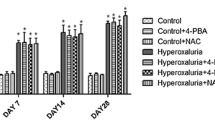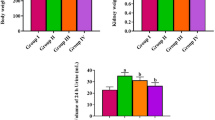Abstract
The aim of this study was to investigate the role of oxidative stress in cystine crystal formation and whether salvianolic acid B, a natural antioxidant, could prevent cystine-mediated oxidative injury in vivo and in vitro. The levels of oxidative stress and antioxidase activity in cystine stone patients were assessed. Then, the oxidative stress exerted by cystine on human kidney-2 (HK-2) cell viability and biochemical parameters including antioxidase activity and antioxidant protein expression were evaluated, and the protective action of salvianolic acid B was also examined. Finally, salvianolic acid B was tested to determine whether it could prevent or reduce renal crystal formation in Slc7a9 knockout mice. The activity levels of superoxide dismutase (SOD) and glutathione peroxidase (GPx) were decreased, and the amount of malondialdehyde (MDA) was increased in patients with cystine stones compared with people without cystine stones (p < 0.05). Significant reductions in cell viability, antioxidase activity and antioxidant protein expression levels were found in the cystine group compared with controls. However, such oxidative injuries were prevented by salvianolic acid B. In the animal study, loose crystals with white spots were seen in the renal parenchyma, bilateral renal pelvis and bladders in the Slc7a9 knockout group. In contrast, no renal crystals were seen in the control group, and markedly fewer crystals with significantly higher antioxidase activity and diminished oxidative stress were detected in the salvianolic acid B group. Cystine cytotoxicity in vitro and cystine stone formation in vivo were associated with oxidative stress, and salvianolic acid B could protect against cystine stone-induced injury.





Similar content being viewed by others
References
Claes DJ, Jackson E (2012) Cystinuria: mechanisms and management. Pediatr Nephrol 27(11):2031
Elmacı AM, Ece A, Akın F (2014) Pediatric urolithiasis: metabolic risk factors and follow-up results in a Turkish region with endemic stone disease. Urolithiasis 42(5):421
Knoll T, Zöllner A, Wendt-Nordahl G et al (2005) Cystinuria in childhood and adolescence: recommendations for diagnosis, treatment, and follow-up. Pediatr Nephrol 20(1):19
Andreassen KH, Pedersen KV, Osther SS et al (2016) How should patients with cystine stone disease be evaluated and treated in the twenty-first century? Urolithiasis 44(1):65
Fattah H, Hambaroush Y, Goldfarb DS, Cystine nephrolithiasis (2014) Transl Androl Urol 3(3):228–233
Chi T, Taylor E, Stoller ML (2014) Treating the cystine stone former presents a singular clinical challenge. Trans Androl Urol 3(3):234
Erickson SB, Vrtiska TJ, Canzanello VJ et al (2011) Cystone for 1 year did not change urine chemistry or decrease stone burden in cystine stone formers. Urol Res 39(3):197
Purohit RS, Stoller ML (2004) Stone clustering of patients with cystine urinary stone formation. Urology 63(4):630
Pietrow PK, Auge BK, Weizer AZ et al (2003) Durability of the medical management of cystinuria. J Urol 169:68–70
Mårtensson J, Denneberg T, Lindell A et al (1990) Sulfur amino acid metabolism in cystinuria: a biochemical and clinical study of patients. [J]. Kidney Int 37(1):143–149
Martins MC, Meyers AA, Whalley NA et al (2002) Cystine: a promoter of the growth and aggregation of calcium oxalate crystals in normal undiluted human urine. J Urol 167(1):317–321
Selvam R (2002) Calcium oxalate stone disease: role of lipid peroxidation and antioxidants. Urol Res 30(1):35–47
Nishizawa-Yokoi A, Tainaka H, Yoshida E et al (2010) The 26S proteasome function and Hsp90 activity involved in the regulation of HsfA2 expression in response to oxidative stress. Plant Cell Physiol 51(3):486–496
Dantas AS, Mj ARC, Felipe MS et al (2008) Oxidative stress response in Paracoccidioides brasiliensis: assessing catalase and cytochrome c peroxidase. Mycol Res 112(6):747–756
Thomas K, Wong K, Withington J, Bultitude M, Doherty A (2014) Cystinuria-a urologist’s perspective. Nat Rev Urol 11(5):270–277
Nancollas GH, Henneman ZJ (2010) Calcium oxalate: calcium phosphate transformations. Urolithiasis 38(4):277–280
Saravakos P, Kokkinou V, Giannatos E (2014) Cystinuria: current diagnosis and management. Urology 83(4):693–699
Khaskhali MH, Byer KJ, Khan SR (2009) The effect of calcium on calcium oxalate monohydrate crystal-induced renal epithelial injury. Urolithiasis 37(1):1
Hirose M, Yasui T, Okada A, Hamamoto S, Shimizu H, Itoh Y (2009) Renal tubular epithelial cell injury and oxidative stress induce calcium oxalate crystal formation in mouse kidney: original article: laboratory investigation. Int J Urol 17(1):83–92
Huang HS, Ma MC (2015) High sodium-induced oxidative stress and poor anticrystallization defense aggravate calcium oxalate crystal formation in rat hyperoxaluric. Kidneys PLoS One 10(8):e0134764
Fishman AI, Green D, Lynch A, Choudhury M, Eshghi M, Konno S (2013) Preventive effect of specific antioxidant on oxidative renal cell injury associated with renal crystal formation. Urology 82(2):1–7
Lu X, Wang C, Liu B (2015) The role of Cu/Zn-SOD and Mn-SOD in the immune response to oxidative stress and pathogen challenge in the clam Meretrix meretrix. Fish Shellfish Immunol 42(1):58–65
Pirinccioglu AG, Gökalp D, Pirinccioglu M et al (2010) Malondialdehyde (MDA) and protein carbonyl (PCO) levels as biomarkers of oxidative stress in subjects with familial hypercholesterolemia. Clin Biochem 43(15):1220–1224
Chen L, Li Y, Yin W et al (2016) Combination of chlorogenic acid and salvianolic acid B protects against polychlorinated biphenyls-induced oxidative stress through Nrf2. Environ Toxicol Pharmacol 46:255–263
Zhao GR, Zhang HM, Ye TX et al (2008) Characterization of the radical scavenging and antioxidant activities of danshensu and salvianolic acid B. Food Chem Toxicol 46(1):73
Pullar JM, Carr AC, Vissers MC (2013) Vitamin C supplementation and kidney stone risk. N Z Med J 126(126):133–134
Hoffer LJ (2013) Ascorbic acid supplements and kidney stone risk. Jama Intern Med 173(14):1384
Tiselius HG (2010) New horizons in the management of patients with cystinuria. Curr Opin Urol 20(2):169–173
Funding
This study was financially supported by Science development foundation of Nanjing Medical University (2017NJMUZD106).
Author information
Authors and Affiliations
Contributions
YFZ: conception and design, collection and/or assembly of data, data analysis and interpretation, financial support, manuscript writing, and final approval of manuscript; LWX: data analysis, manuscript writing, and final approval of manuscript; KL, LHZ and YZG: performed the experiments and data collection; RPJ: conception and design, manuscript preparation, financial and administrative support, and final approval of manuscript.
Corresponding author
Ethics declarations
Conflict of interest
The authors indicated no potential conflicts of interest.
Ethical approval
All procedures performed in studies involving human participants were in accordance with the ethical standards of the institutional and/or national research committee and with the 1964 Helsinki declaration and its later amendments or comparable ethical standards. All applicable international, national, and/or institutional guidelines for the care and use of animals were followed.
Informed consent
Informed consent was obtained from all individual participants included in the study.
Additional information
Publisher’s Note
Springer Nature remains neutral with regard to jurisdictional claims in published maps and institutional affiliations.
Rights and permissions
About this article
Cite this article
Yifan, Z., Luwei, X., Kai, L. et al. Protective effect of salvianolic acid B against oxidative injury associated with cystine stone formation. Urolithiasis 47, 503–510 (2019). https://doi.org/10.1007/s00240-019-01114-4
Received:
Accepted:
Published:
Issue Date:
DOI: https://doi.org/10.1007/s00240-019-01114-4




